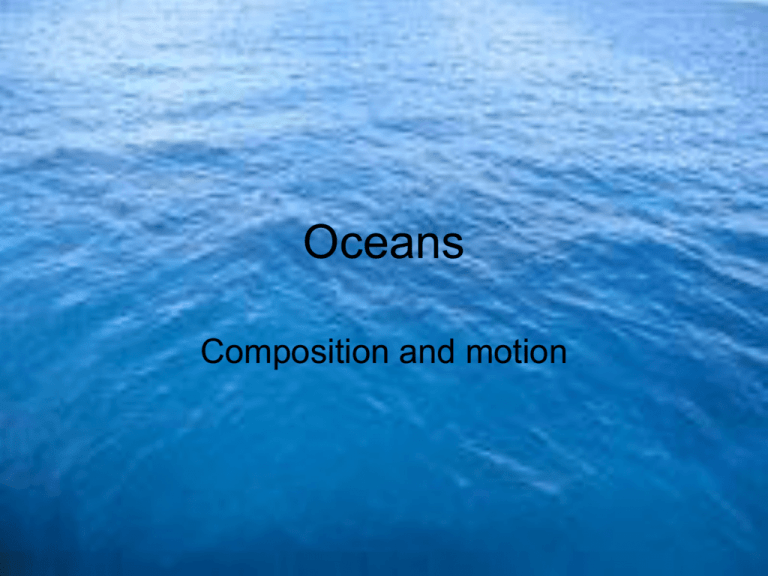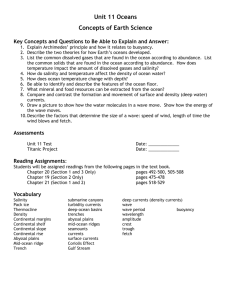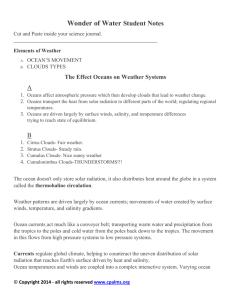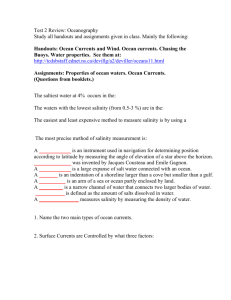Oceans
advertisement

Oceans Composition and motion Oceans - Composition Dissolved Gases • Ocean water is a complex mixture of chemicals that sustains a variety of plant and animal life. • The two main gases in the atmosphere, – nitrogen, N2, and – oxygen, O2, are also the main gases dissolved in ocean water. • While carbon dioxide, CO2, is not a major component of the atmosphere, a large amount of this gas is dissolved in ocean water. • Gases can enter the ocean from streams, volcanoes, organisms, and the atmosphere. Temperature and Dissolved Gases • Gases dissolve more readily in cold water than in warm water. • If the water temperature rises, gases will be released into the atmosphere. • Therefore, the ocean and the atmosphere are continuously exchanging gases as water temperature changes. Dissolved Solids • Ocean water is 96.5% pure water, or H2O. • Dissolved solids make up about 3.5% of the mass of ocean water. • These dissolved solids, commonly called sea salts, give the ocean its salty taste. Most Abundant Elements The six most abundant elements in ocean water are: – – – – – – chlorine, sodium, magnesium, sulfur, calcium, potassium. Dissolved Solids • The salt halite, which is made of sodium and chloride ions, makes up more than 85% of the ocean’s dissolved solids. • Trace elements are elements that exist in very small amounts. Sources of Dissolved Solids • Most of the elements that form sea salts come from three main sources: – volcanic eruptions, – chemical weathering of rock on land, and – chemical reactions between sea water and newly formed sea-floor rocks. • Each year, rivers carry about 400 billion kilograms of dissolved solids into the ocean. Sources of Dissolved Solids • As water evaporates from the ocean, salts and other minerals remain in the ocean. Salinity of Ocean Water • salinity a measure of the amount of dissolved salts in a given amount of liquid • Salinity is measured by the number of grams of dissolved solids in 1,000 g of ocean water. • The ocean is about 3.5% salts. (fresh water is less than 0.1% salt or has a salinity of 1‰.) (Modern instruments measure salinity by recording the conductivity of water, or how easily electricity moves through the water. The higher the salinity of water, the better its conductivity.) Factors that Change Salinity • Where the rate of evaporation is high, the salinity of surface water increases. • Therefore, in equatorial water, where the rate of precipitation is highest, the salinity is lower than it is in subtropical water, where the rate of evaporation is highest. • Over most of the surface of the ocean, salinity ranges from 33‰ to 36‰. • Salinity at particular locations can vary greatly. • September 2005 Temperature of Ocean Water • Like ocean salinity, ocean temperature varies depending on depth and location on the surface of the oceans. • The range of ocean temperatures is affected by the amount of solar energy an area receives and by the movement of water in the ocean. Surface Water • The mixing of the ocean’s surface water distributes heat downward to a depth of 100m to 300m. • The temperature of surface water decreases as latitude increases. Therefore, polar surface waters are much cooler than the surface waters in the tropics. • Because ocean water freezes at about -1.9°C, vast areas of sea ice exist in polar oceans. • In the middle latitudes, the ocean surface temperature varies depending on the seasons. Density of Ocean Water • density the ratio of the mass of a substance to the volume of the substance; • Two factors affect the density of ocean water: salinity and the temperature of the water. • The large amount of dissolved solids in ocean water makes it denser than pure fresh water. • Ocean water becomes denser as it becomes colder and less dense as it becomes warmer. Density of Ocean Water • Water temperature affects the density of ocean water more than salinity does. • Therefore, the densest ocean water is found in the polar regions, where the ocean surface is the coldest. – This cold, dense water sinks and moves through the ocean basins near the ocean floor. World’s Ocean conveyor belt Ocean Waves • wave a periodic disturbance in a solid, liquid, or gas as energy is transmitted through a medium • One kind of wave is described as the periodic up-and-down movement of water. • A wave has two basic parts-a crest and a trough. • The crest is the highest point of a wave. • The trough is the lowest point between two crests. • The wavelength is the horizontal distance between two consecutive crests or between two consecutive troughs. Draw a wave Wave Energy • The longer wind blows from a given direction, the more energy is transferred from wind to water and the larger the wave becomes. • Because of their large surface area, larger waves receive more energy from the wind than smaller waves do. • Thus, larger waves grow larger and smaller waves die out. (The energy is transferred from the wind to waves by friction) Why do waves break? • As the wave moves in to shore, the bottom gets shallower and shallower. • If the bottom is shallower, the wave moves slower. As the wave approaches the shore, the leading edge of the wave is in shallower water than the trailing edge. Why do wave break? The top of the wave tumbles forward, eventually breaking over the leading edge. • In this one limited situation, it is true that for a short time the water is actually moving forward with the wave; the water in the crest of the wave is carried forward by its greater speed. • The wave starts to break at the ‘depth of disturbance, which is about half the wave length. Ocean Currents • current a horizontal movement of water in a well-defined pattern, such as a river or stream • Scientists place ocean currents into two major categories: – surface currents – deep currents. Surface current • a horizontal movement of ocean water that is caused by wind and that occurs at or near the ocean’s surface • Surface currents are controlled by three factors: – air currents (wind) – Earth’s rotation – location of the continents • Because wind is moving air, wind has kinetic energy. • As energy is transferred from the air to the ocean, the water at the ocean’s surface begins to move. Factors That Affect Surface Currents: Coriolis Effect • Coriolis effect the apparent curving of the path of a moving object from an otherwise straight path due to Earth’s rotation • Wind belts and ocean currents follow a curved or circular pattern that is caused by Earth’s rotation. Global Wind Belts Global wind belts, such as the trade winds and westerlies, are a major factor affecting the flow of ocean surface water. • In both hemispheres, trade-wind belts push currents westward across the tropical latitudes of all three major oceans. • Westerlies push ocean currents eastward in the higher latitudes of the Northern and Southern Hemispheres. Continental Barriers • The continents act as barriers to surface currents. • When a surface current flows against a continent, the current is deflected and divided. • The continents are another major influence on surface currents. Gyres • gyre a huge circle of moving ocean water found above and below the equator • Wind belts and the Coriolis effect cause huge circles of moving water, called gyres, to form. • In the Northern Hemisphere, water flow in gyres is to the right, or clockwise. • In the Southern Hemisphere, the flow is to the left, or counterclockwise. Major Surface Currents Major Surface Currents Equatorial Currents • Warm equatorial currents are located in the Atlantic, Pacific, and Indian Oceans. • Each of these oceans has two warm-water equatorial currents that move in a westward direction. • Between these westward-flowing currents lies a weaker, eastward-flowing current called the Equatorial Countercurrent. Major Surface Currents, continued Currents in the Southern Hemisphere • In the most southerly regions of the oceans, constant westward winds produce the world’s largest current, the Antarctic Circumpolar Current, also known as West Wind Drift. • No continents interrupt the movement of this current that completely circles Antarctica and crosses all three major oceans. Major Surface Currents, continued Currents in the North Atlantic • Gulf Stream the swift, deep, and warm Atlantic current that flows along the eastern coast of the United States toward the northeast • South of Greenland, the Gulf Stream widens and slows until it becomes a vast, slow-moving warm current known as the North Atlantic Current. • Near western Europe, the North Atlantic Current splits. Major Surface Currents, continued Currents in the North Atlantic, continued • The Gulf Stream, the North Atlantic Current, the Canary Current, and the North Equatorial Current form the North Atlantic Gyre. • At the center of this gyre lies a vast area of calm, warm water called the Sargasso Sea. Major Surface Currents, continued Currents in the North Pacific • The patterns of currents in the North Pacific is similar to that in the North Atlantic. • The warm Kuroshio Current, the Pacific equivalent of the Gulf Stream, flows northward along the east coast of Asia. This current then flows toward North America as the North Pacific Drift. • It eventually flows southward along the California coast as the cool California Current. Deep Currents • deep current a streamlike movement of ocean water far below the surface • Deep currents form as cold, dense water of the polar regions sinks and flows beneath warmer ocean water. • The movement of polar waters is a result of differences in density. • Temperature determines density. Salinity, too, helps determines the density of water. Deep Currents, continued Antarctic Bottom Water • The temperature of the water near Antarctica is very cold, 2 °C. The water’s salinity is high. These two factors make the water off the coast of Antarctica the densest and coldest ocean water in the world. • This dense, cold water sinks to the ocean bottom and forms a deep current called the Antarctic Bottom Water. Deep Currents, continued Deep Currents, continued North Atlantic Deep Water • In the North Atlantic, south of Greenland, the water is very cold and has a high salinity. This cold, salty water forms a deep current that moves southward under the northward flowing Gulf Stream. • The dense, highly saline water of the Mediterranean Sea forms a deep current as it flows through the strait of Gibraltar and into the less dense Atlantic Ocean. Roaming Rubber Duckies








